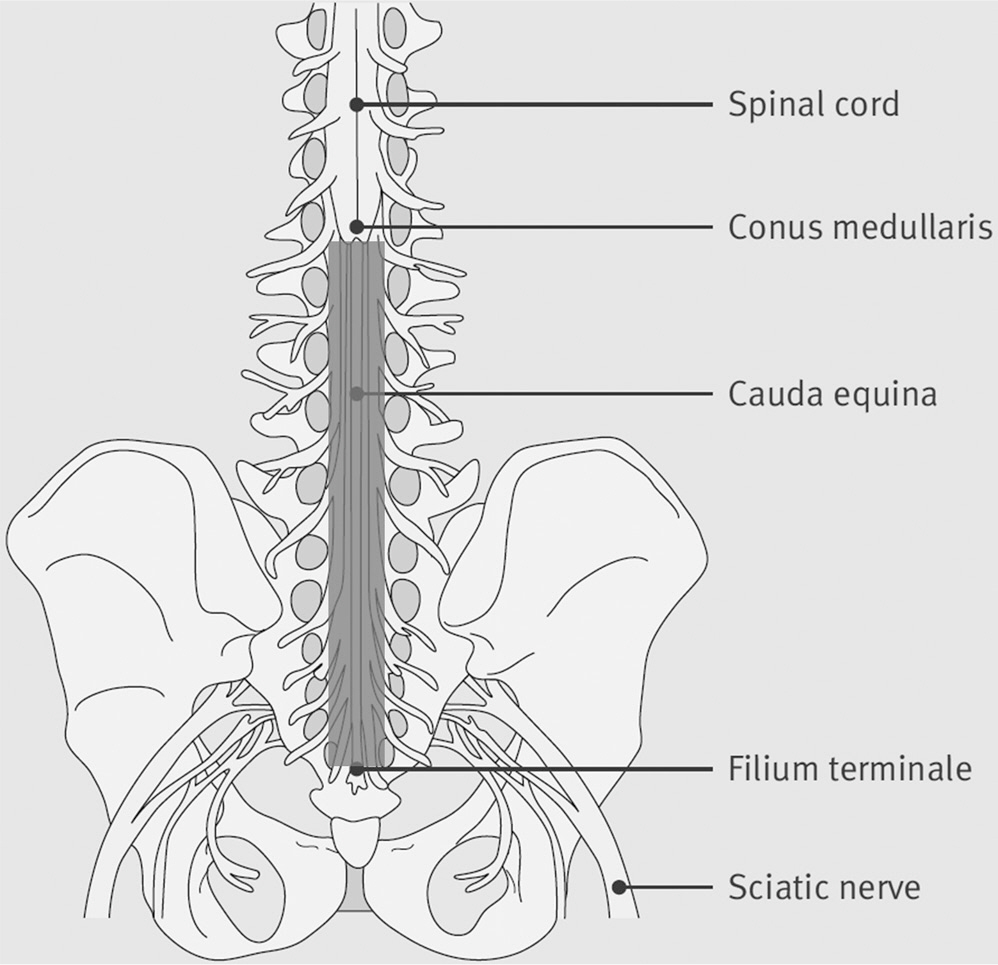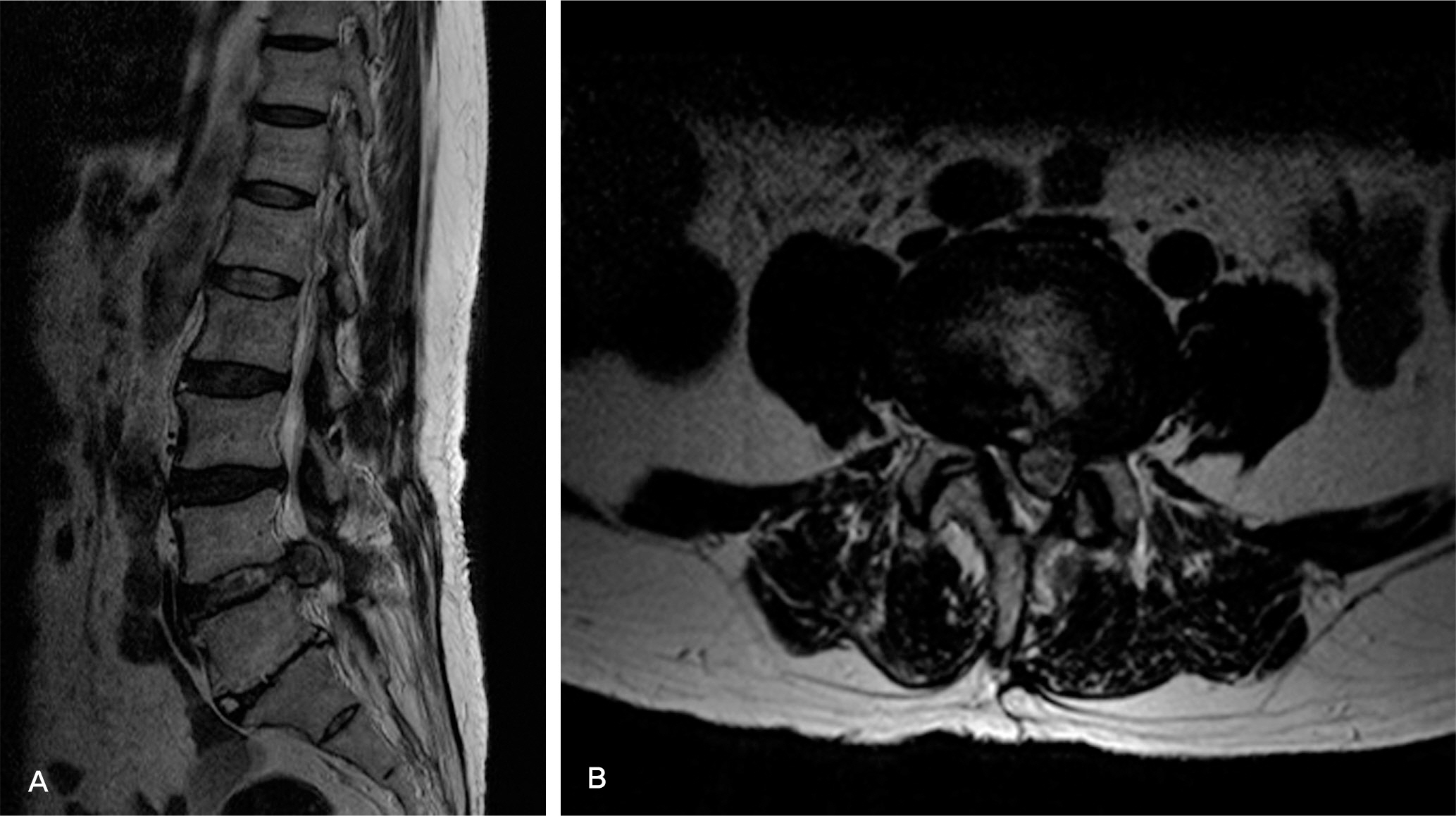J Korean Soc Spine Surg.
2013 Dec;20(4):204-209. 10.4184/jkss.2013.20.4.204.
Causes and Clinical Manifestations of Cauda Equina Syndrome
- Affiliations
-
- 1Department of Orthopaedic Surgery, Asan Medical Center, College of Medicine, University of Ulsan, Seoul, Korea. baski@amc.seoul.kr
- KMID: 1896952
- DOI: http://doi.org/10.4184/jkss.2013.20.4.204
Abstract
- STUDY DESIGN: A literature review.
OBJECTIVES
To describe the causes and clinical characteristics of cauda equina syndrome. SUMMARY OF LITERATURE REVIEW: The cauda equina syndrome, complex symptoms and signs expressed as variable clinical manifestation, has rare incidence but needs attention since it can bring about serious complications and sequales if neglected.
MATERIALS AND METHODS
The Author reviewed articles reporting the causes and clinical manifestation of cauda equina syndrome.
RESULTS
There are marked inconsistencies in the current evidence base surrounding the definition due to various clinical presentation of cauda equina syndrome.
CONCLUSION
As there is no symptom or sign which has an absolute diagnostic value in establishing the diagnosis of cauda equina syndrome, any patient in whom a clinical suspicion of cauda equina syndrome arises must undergo urgent magnetic resonance imaging for diagnosis.
Figure
Reference
-
1. Mixter WJ, Barr JS. Rupture of the intervertebral disc with involvement of the spinal canal. N Engl J Med. 1934; 211:210–5.
Article2. Fraser S, Roberts L, Murphy E. Cauda equine syndrome: a literature review of its definition and clinical presentation. Arch Phys Med Rehabil. 2009; 90:1964–8.3. Mooney V. Differential diagnosis of low back disorders: principles of classification. Frymore JW, editor. The adult spine. New York: Raven Press;1991. p. 1559–60.4. Deyo RA, Rainville J, Kent DL. What can the history and physical examination tell us about low back pain. JAMA. 1992; 268:760–5.
Article5. Kostuik JP, Harrington I, Alexander D, Rand W, Evans D. Cauda equine syndrome and lumbar disc herniation. J Bone Joint Surg Am. 1986; 68:386–91.6. Shapiro S. Cauda equina syndrome secondary to lumbar disc herniation. Neurosurgery. 1993; 32:743–7.
Article7. Patel NM, Curtis RN, Weiner BK. Aortic dissection presenting as an acute cauda equine syndrome. J Bone Joint Surg Am. 2002; 84:1430–2.8. Mohit AA, Fisher DJ, Matthews DC, Hoffer E, Avel-lino AM. Inferior vena cava thrombosis causing acute cauda equine syndrome. J Neurosurg (1 Suppl Pediatrics). 2006; 104:46–9.9. Ahn NU, Ahn UM, Nallamshetty L, Springer BD, Buchowski JM, Funches L, et al. Cauda equina syndrome in ankylosing spondylitis (the CES-AS syndrome): meta-analysis of outcomes after medical and surgical treatments. J Spinal Disord. 2001; 14:427–33.
Article10. Sant SM, O'Connell D. Cauda equina syndrome in ankylosing spondylitis: a case report and review of the literature. Clin Rheumatol. 1995; 14:224–6.
Article11. Ea HK, Lioté F, Lot G, Bardin T. Cauda equina syndrome in ankylosing spondylitis: successful treatment with lumboperitoneal shunting. Spine (Phila Pa 1976). 2010; 35:E1423–9.12. Morandi X, Riffaud L, Chabert E, Brassier G. Acute non-traumatic spinal subdural hematomas in three patients. Spine (Phila Pa 1976). 2001; 26:E547–51.
Article13. Kou J, Fischgrund J, Biddinger A, Herkowitz H. Risk factors for spinal epidural hematoma after spinal surgery. Spine (Phila Pa 1976). 2002; 27:1670–3.
Article14. Podnar S, Trsinar B, Vodusek DB. Bladder Dysfunction in Patients With Cauda Equina Lesions. Neurourol Urody. 2006; 25:23–31.
Article15. Frenckner B, Ihre T. Influence of autonomic nerves on the internal and sphincter in man. Gut. 1976; 17:306–12.
Article16. Bruninga K, Camilleri M. Colonic motility and tone after spinal cord and cauda equina injury. American Journal of Gastroenterology. 1997; 92:891–4.17. Giuliano FA, Rampin O, Benoit G, Jardin A. Neural control of penile erection. Urol Clin North Am. 1995; 22:747–66.
Article18. Podnar S, Oblak C, Vodusek DB. Sexual function in men with cauda equina lesions: a clinical and electromyographic study. J Neurol Neurosurg Psychiatry. 2002; 73:715–20.
Article19. Della-Giustina D. Emergency department evaluation and treatment of back pain. Emerg Med Clin North Am. 1999; 17:877–93.
Article20. Todd NV. For debate – guidelines for the management of suspected cauda equine syndrome. Br J Neurosurg. 2010; 24:387–90.21. Kennedy JG, Soffe KE, McGrath A, Stephens MM, Walsh MG, McManus F. Predictors of outcome in cauda equine syndrome. Eur Spine J. 1999; 8:317–22.22. Ma B, Wu H, Jia LS, Yuan W, Shi GD, Shi JG. Cauda equina syndrome: a review of clinical progress. Chin Med J. 2009; 122:1214–22.23. Bell DA, Collie D, Statham PF. Cauda equina syndrome: what is the correlation between clinical assessment and MRI scanning? Br J Neurosurg. 2007; 21:201–3.24. Balasubramanian K, Kalsi P, Greenough CG, Kuskoor Seetharam MP. Reliability of clinical assessment in diagnosing cauda equina syndrome. Br J Neurosurg. 2010; 24:383–6.
Article25. Domen PM, Hofman PA, van Santbrink H, We-ber WE. Predictive value of clinical characteristics in patients with suspected cauda equina syndrome. Eur J Neurol. 2009; 16:416–9.
Article26. Ahn UM, Ahn NU, Buchowski JM, Garrett ES, Sieber AN, Kostuik JP. Cauda equina syndrome secondary to lumbar disc herniation: a meta-analysis of surgical outcomes. Spine (Phila Pa 1976). 2000; 25:1515–22.27. McCarthy MJ, Aylott CE, Grevitt MP, Hegarty J. Cauda equina syndrome: factors affecting longterm functional and sphincteric outcome. Spine (Phila Pa 1976). 2007; 32:207–16.28. Yang JY, Lee JK, Song HS, Joo YB, Cha SM. Clinical outcome based cauda equina syndrome scoring system for pre-diction of prognosis. J Korean Soc Spine Surg. 2011; 18:57–63.
Article29. Gleave JR, Macfarlane R. Cauda equina syndrome: what is the relationship between timing of surgery and outcome? Br J Neurosurg. 2002; 16:325–8.
Article30. Gitelman A, Hishmeh S, Morelli BN, et al. Cauda equina syndrome: a comprehensive review. Am J Ortho. 2008; 37:556–62.
- Full Text Links
- Actions
-
Cited
- CITED
-
- Close
- Share
- Similar articles
-
- Cavernous Hemangioma of the Cauda Equina
- Anatomical and Pathophysiological Features of Cauda Equina
- Redundant Nerve Root Syndrome of the Cauda Equina
- Hypertrophic Interstitial Neuritis of Cauda Equina: Case Report with Myelographic Findings
- Two Cases of Cavernous Hemangioma of the Cauda Equina: Case Report



